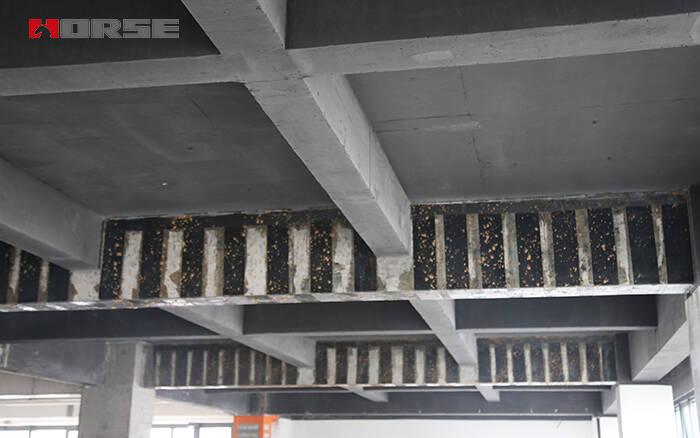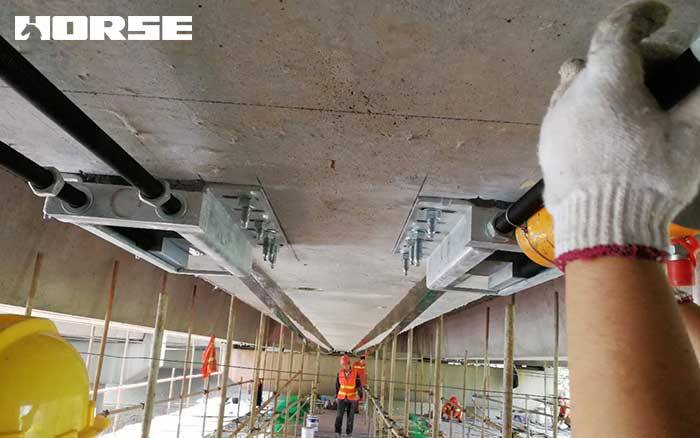Solutions
Horse Construction offers full range of structural strengthening materials with technical supports, documentation supports, products supports, project supports.
FRP Used for Structural Strengthening?

Fiber-reinforced polymer(FRP) is a new type of structural reinforcement material developed in civil engineering in the past 20 years. It is composed of carbon fiber, glass fiber, aramid fiber, basalt fiber and other high-performance fibers mixed with a resin matrix, and composited by a certain processing technology. It is a new type of structural reinforcement material with high strength, high durability, and strong designability.
Since the 1950s and 1960s, FRP has been tried to be used in civil buildings. Since the 1960s, relevant universities, research institutes and material manufacturers in developed areas in Japan, the United States and Europe have used FRP materials to strengthen engineering structures. The research and application have begun, and some effective results have been achieved. my country's research and development of FRP materials in civil engineering began in the mid-1990s. China Metallurgical Construction Research and Research Institute and other units have carried out research on FRP applied to material technology, and have achieved some innovative research results in FRP reinforcement technology and design theory.
This article systematically introduces the construction technology of FRP for the reinforcement and repair of concrete structures in engineering. The external paste reinforcement method, the embedded reinforcement method, the prestressed reinforcement method, the grid/grid reinforcement method and the restraint reinforcement method are analyzed. Finally, the current development of FRP reinforcement application technology is summarized.
FRP repair and reinforcement of concrete structures
FRP reinforced concrete materials mainly use FRP sheets, grid/grid materials and FRP bars. There are various reinforcement methods, which can be divided into external reinforcement and internal reinforcement according to the reinforcement position. External reinforcement mainly includes external paste reinforcement and restraint reinforcement, and internal reinforcement includes embedded reinforcement and grid/grid reinforcement. According to different material treatments, it is divided into prestressed reinforcement and non-prestressed reinforcement methods. According to the role of reinforcement, it is divided into bending reinforcement method, compression reinforcement method, shear reinforcement method and seismic reinforcement method. Either way, it is required to be able to meet the reinforcement requirements of the reinforced structure for design and construction, and give full play to the performance of fiber composite materials. Several main methods are introduced below.
External reinforcement
The external paste reinforcement method is mainly to repair and strengthen the concrete structure by pasting fiber-reinforced composite materials (mainly fiber fabric sheets and fiber boards), which is also called the external fiber composite material method. It is mainly composed of carbon fiber, glass fiber and other composite materials, and uses structural glue to stick to the main force-bearing parts of the component to improve the bending, shear and concrete compressive strength of the section, so as to achieve the purpose of reinforcement.
The materials used in the external paste reinforcement method are light in weight, high in strength, simple and fast in construction, and can be pasted and reinforced (curved or turned pasted) for structures of various shapes. It is suitable for the reinforcement of bending and tension members due to insufficient reinforcement, especially the reinforcement of simply supported beams and slabs and continuous beams and slabs without obstacles. In application, for newly built projects with a long design life, the externally bonded fiber composite material method should be reinforced with reliable anti-corrosion and additional anchoring measures; for frame structure reinforcement, reliable anchoring and node construction measures should be adopted.
Embedded reinforcement method
The embedded reinforcement method mainly uses FRP ribs and strip-shaped FRP plates, slotting on the surface of the members to be reinforced (in the concrete protective layer), and filling them with FRP ribs or strip-shaped FRP plates. The adhesive is used to make the FRP and the component tightly combined to achieve the purpose of shear and bending resistance of the component.
The embedded reinforcement method is characterized by less construction pretreatment workload and short installation time. The FRP material is protected by being embedded in the concrete to avoid adverse effects such as corrosion, abrasion and collision. It is especially suitable for the reinforcement of the negative moment area of bridge decks and continuous beams. It can be used in high temperature and high humidity reinforcement projects that are difficult to construct by external sticking method. It is convenient to anchor with adjacent components during installation. Compared with the FRP external bonding method, the advantage of this method is that the bonding surface area of the method and the concrete increases, which improves the utilization rate and reinforcement efficiency of FRP. The surface treatment workload of the concrete components is reduced, the work efficiency is improved, and it is convenient to anchor with the corresponding components. The embedding method can replace epoxy resin with cement-based adhesive, so it can be used in high temperature and high humidity reinforced concrete projects. When used to reinforce the negative moment area of a member, it has advantages compared to other reinforcement methods.

Prestressed reinforcement method
The prestressed reinforcement method mainly uses prestressed fiber cloth, prestressed fiberboard and prestressed fiber reinforcement for design reinforcement. Since the non-prestressed reinforcement technology does not greatly increase the stiffness of the component, it cannot effectively suppress the deformation of the component and the expansion of cracks. In order to give full play to the high-strength advantages of fiber composite materials, the basic principle of prestressed concrete structure technology was used for reference, and the prestressed reinforcement technology was proposed. At present, the more mature technology is the technology of prestressed carbon fiber sheet to reinforce concrete structures. There are systematic design and construction methods, which have been practiced in engineering applications. In addition, prestressed carbon fiber board reinforcement has also been applied.
Prestressed reinforcement can give full play to the advantages of high strength of fiber reinforced materials. Taking prestressed carbon fiber cloth reinforcement as an example, the prestressed carbon fiber cloth reinforcement technology has the following advantages compared with ordinary carbon fiber cloth reinforcement methods. The light weight and high strength characteristics of carbon fiber cloth can be fully utilized, and the cracking load and yield load of the component can be increased. It can alleviate the stress hysteresis problem of carbon fiber cloth and limit the growth of steel bar stress. It can effectively delay the cracking of components, limit the formation and development of cracks, reduce the width and deflection of cracks, and significantly improve the working performance of the structure.
Grid/grid reinforcement
The grid reinforcement method is to impregnate high-performance continuous fibers such as carbon fiber, glass fiber, or polyamide fiber in a resin with good corrosion resistance to form an overall grid. A method of fixing the surface of the concrete member by anchor bolts, and then spraying polymer cement mortar to form a whole with the original concrete, thereby improving the bearing capacity and durability of the structure.
The mesh reinforcement method ensures that the mesh reinforcement works in coordination with the concrete through the mechanical anchoring effect of the intersection of the mesh reinforcement, which can effectively ensure the integrated work of the structure. The fiber mesh material is light and thin, and the intersection of the mesh is on the same plane, so its cross-section is thinner than that of the steel bar. It is suitable for transportation, does not require cranes, and is not restricted by construction sites. No rust, the reinforced fiber is made of resin with good corrosion resistance and will not corrode, especially in cold areas and salt-resistant in coastal areas. The continuous reinforcing fiber is distributed in two directions, and the adhesion and slip resistance is very good. Coupled with the high strength and high elasticity of the material itself, the reinforcement effect is obvious.
This technology can be used for flexural reinforcement of beams, slabs and other components, shear reinforcement of beam sides, and seismic reinforcement of piers and other columns. It can also be used to reinforce curved surfaces such as tunnels, and can also be used to replace steel bars in new structures.
Compared with the externally attached FRP sheet reinforcement method, the grid reinforcement method has the following advantages in addition to the characteristics of high strength and corrosion resistance. The continuous fiber is distributed in two directions. Under the protection of mechanical anchoring and polymer mortar, it is not suitable for peeling damage from the original concrete layer. The performance of the material is fully utilized and the reinforcement effect is obvious. Under the protection of polymer mortar, impact resistance, fire resistance and durability are improved. When performing bending reinforcement, the rigidity and crack resistance of the reinforcement member can also be improved. In new structures, it can replace steel bars in some anti-magnetic, anti-shielding and explosion-proof structures.
Restraint reinforcement
The restraint reinforcement method refers to the use of fiber-reinforced composite materials to effectively restrain the lateral deformation of concrete to improve its compression performance. This method mainly reinforces the compressive members, and the reinforcement method also belongs to the external sticking reinforcement method, but the specific construction technology is different due to different reinforcement requirements.
Because FRP has a high strength-to-mass ratio (light weight and high strength), superior corrosion resistance. After reinforcement, there is almost no increase in the cross-sectional size of the component, and the use of indoor reinforcement will not reduce the use area of the room, and it will not change the structural system and spatial layout of the house, which has a small impact on the structural function. The advantages of simple reinforcement construction and no need for large-scale equipment make FRP constrained reinforced concrete columns an effective reinforcement method.
This method is suitable for the reinforcement of eccentric compression columns, axial compression and bridge piers. The bearing capacity and deformation capacity of reinforced concrete columns reinforced with FRP sheets will be significantly enhanced.
You can find anything here you are in need of, have a trust trying on these products, you will find the big difference after that.

High strength carbon fiber reinforced polymer (CFRP) strip / laminate / plate for structural strengthening and concrete repair

Prestressed carbon fiber reinforced polymer(CFRP) plate for slab, beam strengthening to increase stiffness, reduce distortion and deflection of members, reduce the cracks, avoid and stop cracking.

High strength, unidirectional carbon fiber sheet pre-saturated to form a carbon fiber reinforced polymer (CFRP) sheet used to strengthen structural concrete elements.